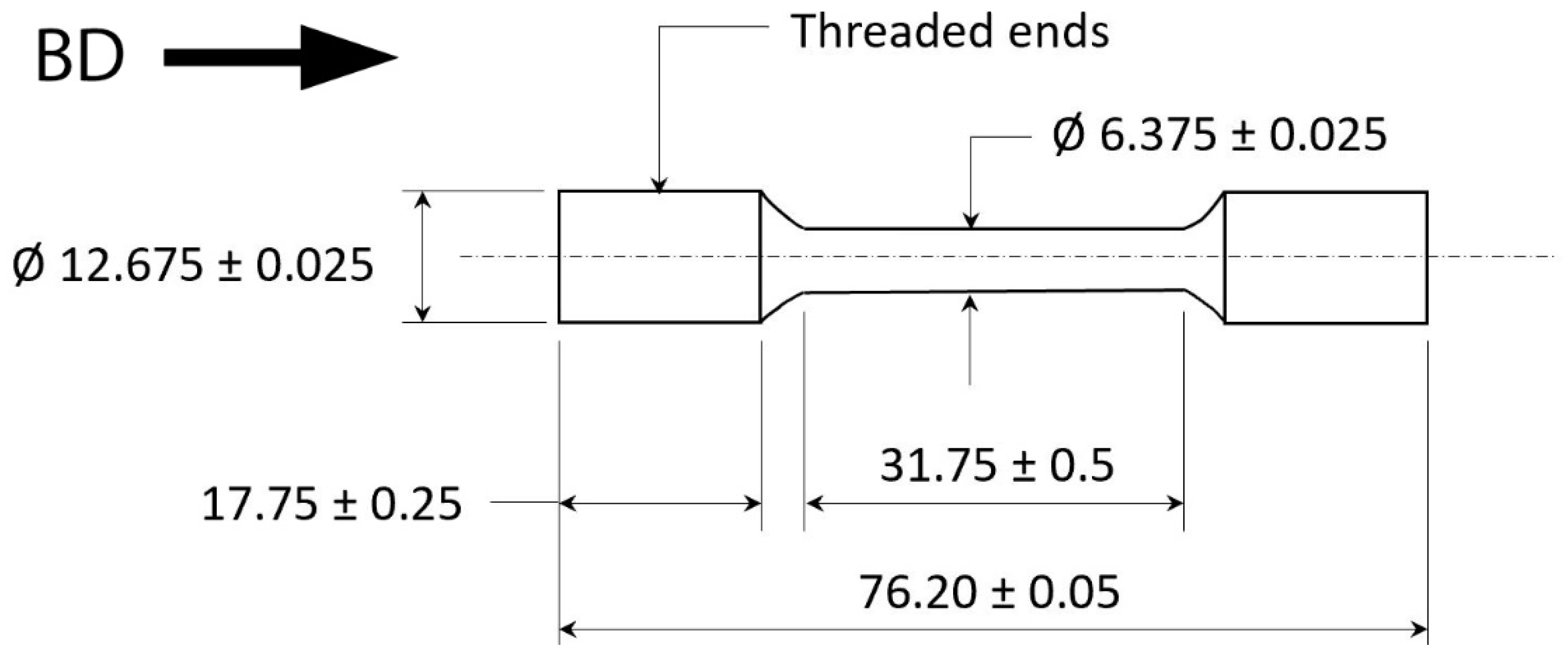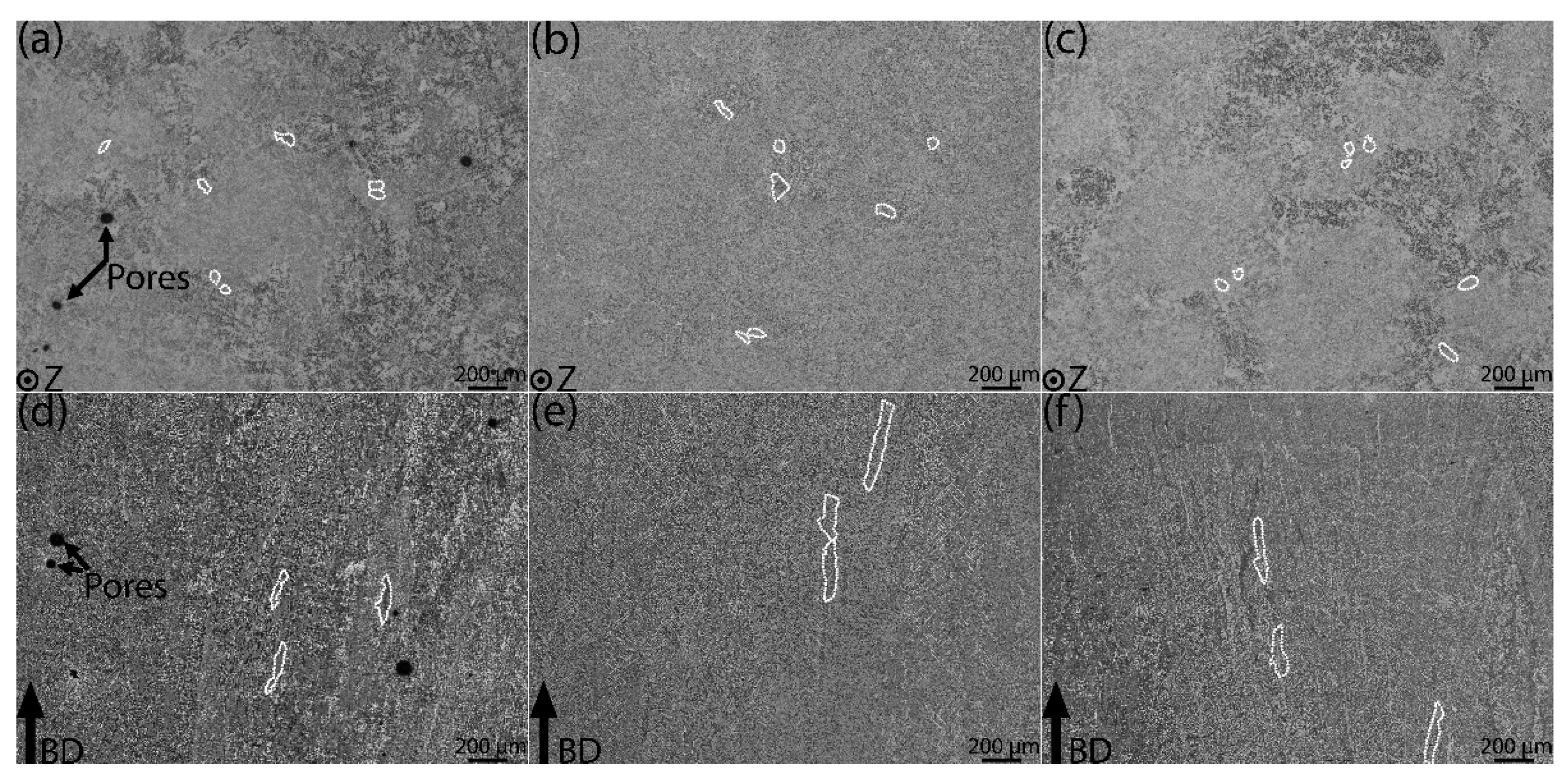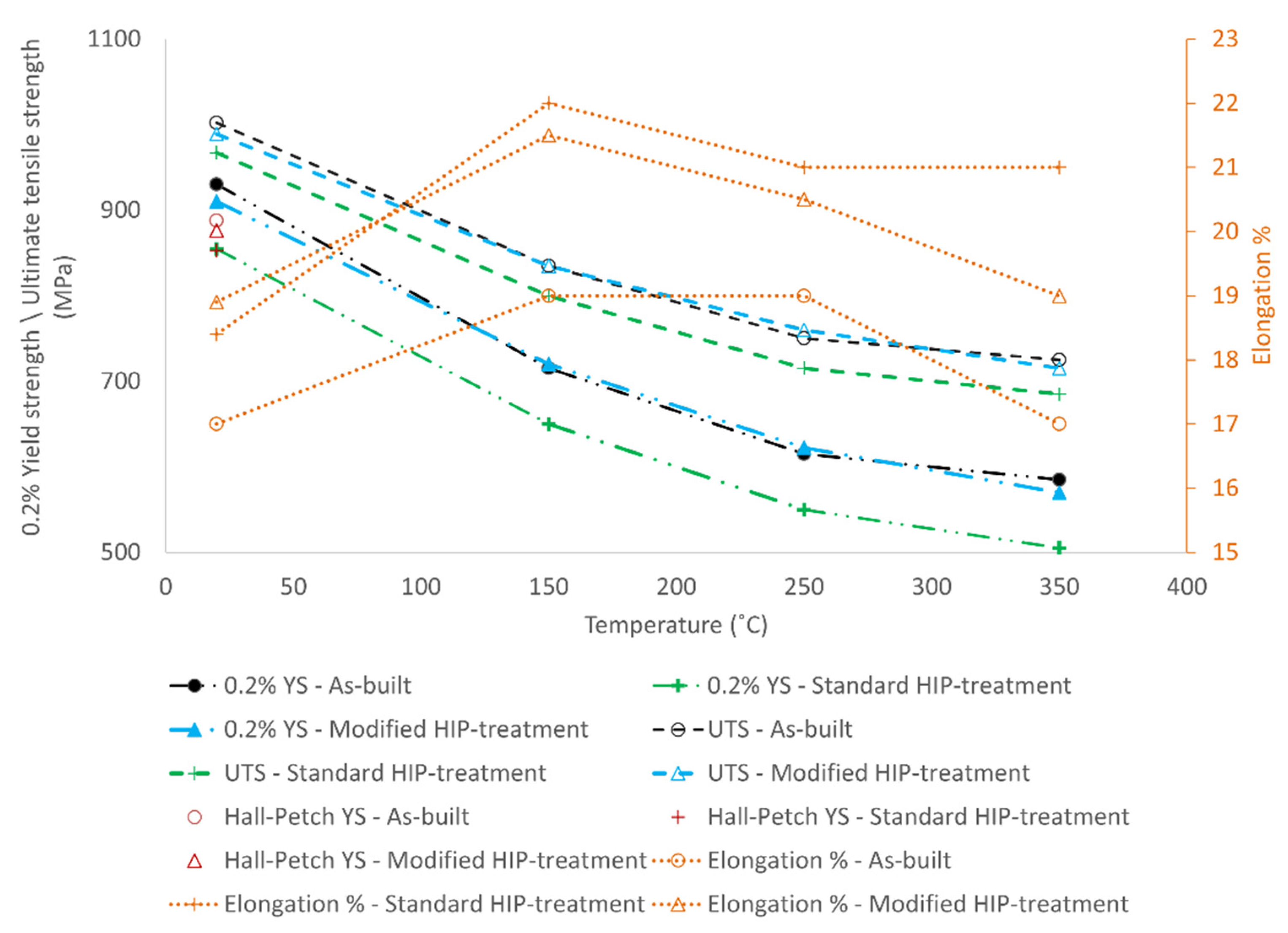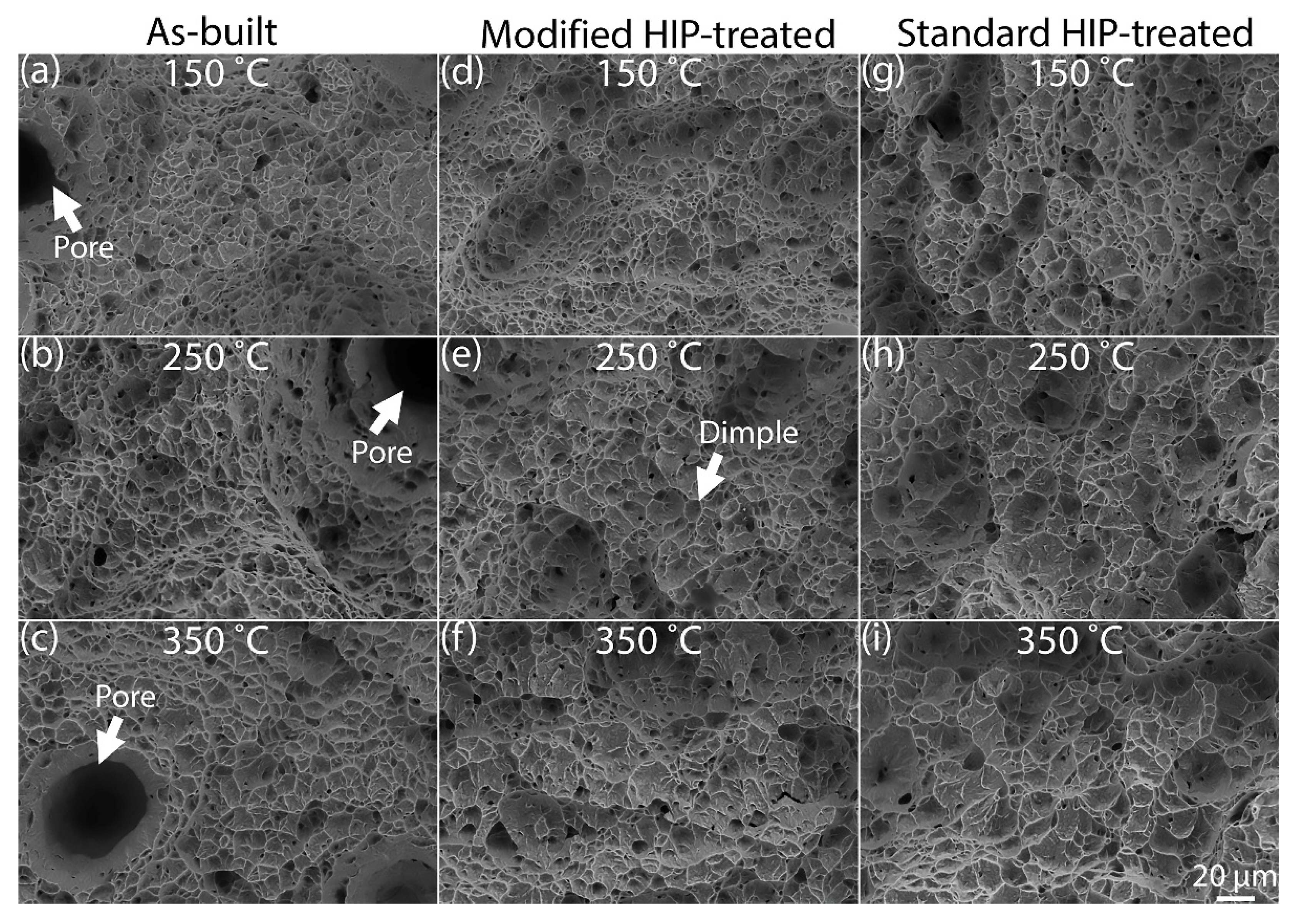Elevated-Temperature Tensile Properties of Low-Temperature HIP-Treated EBM-Built Ti-6Al-4V
Abstract
:1. Introduction
2. Materials and Methods
2.1. Material and HIP Treatment
2.2. Metallographic Investigation
2.3. Tensile Testing
3. Results
3.1. Microstructure and Porosity
3.2. Tensile Properties
3.3. Fractography
4. Discussion
4.1. Microstructure and Porosity
4.2. Effect of Temperature on Tensile Properties
5. Conclusions
- No difference in prior β grain size was observed between the three different materials.
- The smallest α lath thickness was found in the as-built material, while the α lath thickness increased with post-HIP-treatment temperature.
- Following the Hall–Petch relationship, the α lath thickness impacted the yield strength of the material. The standard HIP-treated material with maximum α lath thickness had about a 10–14% lower yield strength than the as-built and modified HIP-treated counterparts.
- A reduction in yield strength with increased temperature was observed for all three material conditions. At 350 °C, the yield strength dropped to about 37–41% of the corresponding room-temperature yield strengths, respectively.
- Compared with ductility at room temperature, the elongation % value increased by 2–4% at 150 °C, followed by a decrease of 1–3% at 350 °C.
- The yield strength was not affected by the porosity, but the porosity negatively impacted the ductility. The as-built material, with larger pores, had the maximum yield strength and minimum ductility.
- The fracture surfaces had dimples and their sizes varied with test temperature and α lath thickness. The specimens tensile-tested at 350 °C showed a 1.7x larger dimple size than those found in specimens tensile-tested at 150 °C. The material with the widest α lath size showed the largest dimple sizes.
Author Contributions
Funding
Institutional Review Board Statement
Data Availability Statement
Acknowledgments
Conflicts of Interest
References
- Boyer, R.R. An Overview on the Use of Titanium in the Aerospace Industry. Mater. Sci. Eng. A 1996, 213, 103–114. [Google Scholar] [CrossRef]
- Huang, R.; Riddle, M.; Graziano, D.; Warren, J.; Das, S.; Nimbalkar, S.; Cresko, J.; Masanet, E. Energy and Emissions Saving Potential of Additive Manufacturing: The Case of Lightweight Aircraft Components. J. Clean. Prod. 2016, 135, 1559–1570. [Google Scholar] [CrossRef] [Green Version]
- Liu, S.; Shin, Y.C. Additive Manufacturing of Ti6Al4V Alloy: A Review. Mater. Des. 2019, 164, 107552. [Google Scholar] [CrossRef]
- Safdar, A.; Wei, L.Y.; Snis, A.; Lai, Z. Evaluation of Microstructural Development in Electron Beam Melted Ti-6Al-4V. Mater. Charact. 2012, 65, 8–15. [Google Scholar] [CrossRef]
- Al-Bermani, S.S.; Blackmore, M.L.; Zhang, W.; Todd, I. The Origin of Microstructural Diversity, Texture, and Mechanical Properties in Electron Beam Melted Ti-6Al-4V. Metall. Mater. Trans. A Phys. Metall. Mater. Sci. 2010, 41, 3422–3434. [Google Scholar] [CrossRef]
- Neikter, M. Microstructure and Hydrogen Embrittlement of Additively Manufactured Ti-6Al-4V. Ph.D. Thesis, Luleå University of Technology, Luleå, Sweden, 2019. [Google Scholar]
- Rawal, S.; Brantley, J.; Karabudak, N. Additive Manufacturing of Ti-6Al-4V Alloy Components for Spacecraft Applications. In Proceedings of the 2013 6th International Conference on Recent Advances in Space Technologies (RAST), Istanbul, Turkey, 12–14 June 2013; pp. 5–11. [Google Scholar] [CrossRef]
- Koike, M.; Greer, P.; Owen, K.; Lilly, G.; Murr, L.E.; Gaytan, S.M.; Martinez, E.; Okabe, T. Evaluation of Titanium Alloys Fabricated Using Rapid Prototyping Technologies—Electron Beam Melting and Laser Beam Melting. Materials 2011, 4, 1776. [Google Scholar] [CrossRef] [PubMed]
- Tammas-Williams, S.; Withers, P.J.; Todd, I.; Prangnell, P.B. The Influence of Porosity on Fatigue Crack Initiation in Additively Manufactured Titanium Components. Sci. Rep. 2017, 7, 7308. [Google Scholar] [CrossRef]
- Tammas-williams, S.; Withers, P.J.; Todd, I.; Prangnell, P.B. The Effectiveness of Hot Isostatic Pressing for Closing Porosity in Titanium Parts Manufactured by Selective Electron Beam Melting. Metall. Mater. Trans. A 2016, 47, 1939–1946. [Google Scholar] [CrossRef] [Green Version]
- Vogel, S.C.; Bhattacharyya, D.; Viswanathan, G.B.; Williams, D.J.; Fraser, H.L. Phase Transformation Textures in Ti-6Al-4V Alloy. Mater. Sci. Forum 2005, 495–497, 681–686. [Google Scholar] [CrossRef]
- Lütjering, G.; Williams, J.C. Titanium, 2nd ed.; Springer: Berlin/Heidelberg, Germany, 2007; p. 442. ISBN 978-3540713975. [Google Scholar]
- Neikter, M.; Woracek, R.; Durniak, C.; Persson, M.; Antti, M.-L.; Åkerfeldt, P.; Pederson, R.; Zhang, J.; Vogel, S.C.; Strobl, M. Texture of Electron Beam Melted Ti-6Al-4V Measured with Neutron Diffraction. In MATEC Web of Conferences; EDP Sciences: Les Ulis, France, 2020; Volume 321, p. 03021. [Google Scholar] [CrossRef]
- Partridge, P.G. The Crystallography and Deformation Modes of Hexagonal Close-Packed Metals. Metall. Rev. 1967, 12, 169–194. [Google Scholar] [CrossRef]
- Lecomte, J.S.; Philippe, M.J.; Klimanek, P. Plastic Deformation of a Ti-6% Al-4% V Alloy with a Strong Transverse-Type Crystallographic α-Texture at Elevated Temperatures. Mater. Sci. Eng. A 1997, 234–236, 869–872. [Google Scholar] [CrossRef]
- Wang, S.H.; Wei, M.D.; Tsay, L.W. Tensile Properties of LBW Welds in Ti-6Al-4V Alloy at Evaluated Temperatures below 450 °C. Mater. Lett. 2003, 57, 1815–1823. [Google Scholar] [CrossRef]
- Murr, L.E.; Esquivel, E.V.; Quinones, S.A.; Gaytan, S.M.; Lopez, M.I.; Martinez, E.Y.; Medina, F.; Hernandez, D.H.; Martinez, E.; Martinez, J.L.; et al. Microstructures and Mechanical Properties of Electron Beam-Rapid Manufactured Ti–6Al–4V Biomedical Prototypes Compared to Wrought Ti–6Al–4V. Mater. Charact. 2009, 60, 96–105. [Google Scholar] [CrossRef]
- Facchini, L.; Magalini, E.; Robotti, P.; Molinari, A. Microstructure and Mechanical Properties of Ti-6Al-4V Produced by Electron Beam Melting of Pre-alloyed Powders. Rapid Prototyp. J. 2009, 15, 171–178. [Google Scholar] [CrossRef]
- Neikter, M.; Colliander, M.; Schwerz, C.d.A.; Hansson, T.; Åkerfeldt, P.; Pederson, R.; Antti, M.-L. Fatigue Crack Growth of Electron Beam Melted Ti-6Al-4V in High-Pressure Hydrogen. Materials 2020, 13, 1287. [Google Scholar] [CrossRef] [Green Version]
- Bruno, J.; Rochman, A.; Cassar, G. Effect of Build Orientation of Electron Beam Melting on Microstructure and Mechanical Properties of Ti-6Al-4V. J. Mater. Eng. Perform. 2017, 26, 692–703. [Google Scholar] [CrossRef]
- Ghods, S.; Schultz, E.; Wisdom, C.; Schur, R.; Pahuja, R.; Montelione, A.; Arola, D.; Ramulu, M. Electron Beam Additive Manufacturing of Ti6Al4V: Evolution of Powder Morphology and Part Microstructure with Powder Reuse. Materialia 2020, 9, 100631. [Google Scholar] [CrossRef]
- Tiley, J.; Searles, T.; Lee, E.; Kar, S.; Banerjee, R.; Russ, J.C.; Fraser, H.L. Quantification of microstructural features in α/β titanium alloys. Mater. Sci. Eng. A 2004, 372, 191–198. [Google Scholar] [CrossRef]
- Raghavan, S.; Nai, M.L.S.; Wang, P.; Sin, W.J.; Li, T.; Wei, J. Heat Treatment of Electron Beam Melted (EBM) Ti-6Al-4V: Microstructure to Mechanical Property Correlations. Rapid Prototyp. J. 2018, 24, 774–783. [Google Scholar] [CrossRef]
- Galarraga, H.; Warren, R.J.; Lados, D.A.; Dehoff, R.R.; Kirka, M.M.; Nandwana, P. Effects of Heat Treatments on Microstructure and Properties of Ti-6Al-4V ELI Alloy Fabricated by Electron Beam Melting (EBM). Mater. Sci. Eng. A 2017, 685, 417–428. [Google Scholar] [CrossRef] [Green Version]
- Mohammadhosseini, A.; Fraser, D.; Masood, S.H.; Jahedi, M. Microstructure and Mechanical Properties of Ti–6Al–4V Manufactured by Electron Beam Melting Process. Mater. Res. Innov. 2013, 17, s106–s112. [Google Scholar] [CrossRef]
- Eklund, A.; Ahlfors, M.; Bahbou, F.; Wedenstrand, J. Optimizing HIP and Printing Parameters for EBM Ti-6Al-4V. In Proceedings of the Key Engineering Materials; Trans Tech Publications Ltd.: Zürich, Switzerland, 2018; Volume 770 KEM, pp. 174–178. [Google Scholar]
- Rice, R.C.; Jackson, J.L.; Bakuckas, J.; Thompson, S. The Metallic Material Properties Development and Standardization (MMPDS) Handbook; Technical Report; Department of Transportation Federal Aviation Administration: Washington, DC, USA, 2003; p. 1728.
- Standard Test Methods for Tension Testing of Metallic Materials. Available online: https://www.astm.org/e0008_e0008m-16.html (accessed on 3 May 2022).
- Rasband, W. ImageJ. Available online: https://imagej.nih.gov/ij (accessed on 27 April 2022).
- Ridley, N. A Review of the Data on the Interlamellar Spacing of Pearlite. Metall. Mater. Trans. A 1984, 15, 1019–1036. [Google Scholar] [CrossRef]
- Cayron, C. ARPGE: A Computer Program to Automatically Reconstruct the Parent Grains from Electron Backscatter Diffraction Data. J. Appl. Crystallogr. 2007, 40, 1183. [Google Scholar] [CrossRef] [PubMed] [Green Version]
- Standard Test Methods for Determining Average Grain Size. Available online: https://www.astm.org/e0112-13r21.html (accessed on 3 May 2022).
- Standard Test Methods for Elevated Temperature Tension Tests of Metallic Materials. Available online: https://www.astm.org/e0021-17.html (accessed on 3 May 2022).
- Lancaster, R.; Davies, G.; Illsley, H.; Jeffs, S.; Baxter, G. Structural Integrity of an Electron Beam Melted Titanium Alloy. Materials 2016, 9, 470. [Google Scholar] [CrossRef] [Green Version]
- Neikter, M.; Åkerfeldt, P.; Pederson, R.; Antti, M.L.; Sandell, V. Microstructural Characterization and Comparison of Ti-6Al-4V Manufactured with Different Additive Manufacturing Processes. Mater. Charact. 2018, 143, 68–75. [Google Scholar] [CrossRef]
- de Formanoir, C.; Michotte, S.; Rigo, O.; Germain, L.; Godet, S. Electron Beam Melted Ti–6Al–4V: Microstructure, Texture and Mechanical Behavior of the as-Built and Heat-Treated Material. Mater. Sci. Eng. A 2016, 652, 105–119. [Google Scholar] [CrossRef]
- Kumar, P.; Chandran, K.S.R. A Quantitative Relationship to Predict the Effect of Extreme-Sized Pores on Tensile Ductility of Powder Metallurgy Ti-6Al-4V Alloy. In Proceedings of the 13th World Conference on Titanium, San Diego, CA, USA, 16–20 August 2015; pp. 1441–1446. [Google Scholar] [CrossRef]
- Conrad, H.; Doner, M.; DeMeester, B. Critical Review—Deformation and Fracture. In Titanium Science and Technology; Jaffee, R.I., Burte, H.M., Eds.; Plenum Press: New York, NY, USA, 1973; Volume 2, pp. 969–1005. [Google Scholar]
- Gysler, A.; Lütjering, G. Influence of Test Temperature and Microstructure on the Tensile Properties of Titanium Alloys. Metall. Trans. A 1982, 13, 1435–1443. [Google Scholar] [CrossRef]
- Hall, E.O. The Deformation and Ageing of Mild Steel: III Discussion of Results. Proc. Phys. Society. Sect. B 1951, 64, 747. [Google Scholar] [CrossRef]
- Petch, N.J. The Cleavage Strength of Polycrystals. J. Iron Steel Inst. 1953, 174, 25–28. [Google Scholar]
- William, D.; Callister, D.G.R., Jr. Materials Science and Engineering: An Introduction, 10th ed.; John Wiley & Sons: Hoboken, NJ, USA, 2017; ISBN 9781119278566. [Google Scholar]
- Kim, Y.; Song, Y.B.; Lee, S.H. Microstructure and Intermediate-Temperature Mechanical Properties of Powder Metallurgy Ti–6Al–4V Alloy Prepared by the Prealloyed Approach. J. Alloys Compd. 2015, 637, 234–241. [Google Scholar] [CrossRef]







| Sample Description | Reconstructed β Grain Average Intercept Length (μm) | |
|---|---|---|
| Parallel to BD | Perpendicular to BD | |
| As-built | 66 ± 15 | 51± 9 |
| Standard HIP (920 °C, 100 MPa, 2 h) | 58 ± 17 | 59 ± 14 |
| Modified HIP (800 °C, 200 MPa, 2 h) | 58 ± 11 | 57 ± 9 |
| Sample Description | Average α-Lath Thickness (μm) | ||
|---|---|---|---|
| Parallel to BD | Perpendicular to BD | Average Thickness (δα-lath) | |
| As-built | 0.84 ± 0.10 | 0.97 ± 0.14 | 0.91 |
| Standard HIP (920 °C, 100 MPa, 2 h) | 1.54 ± 0.28 | 1.53 ± 0.23 | 1.54 |
| Modified HIP (800 °C, 200 MPa, 2 h) | 1.12 ± 0.14 | 1.01 ± 0.11 | 1.07 |
| Sample Description | Average Porosity Area % | Relative Density % |
|---|---|---|
| As-built | 1.15 ± 1.98 | 98.85 |
| Standard HIP (920 °C, 100 MPa, 2 h) | 0.16 ± 0.12 | 99.84 |
| Modified HIP (800 °C, 200 MPa, 2 h) | 0.19 ± 0.06 | 99.81 |
| Sample Description | Average Dimple Size (μm) on Fracture Surfaces for the Different Materials Tested at Different Temperature | ||
|---|---|---|---|
| 150 °C | 250 °C | 350 °C | |
| As-built | 3.9 ± 0.43 | 5.1 ± 0.71 | 6.6 ± 1.18 |
| Modified HIP (800 °C, 200 MPa, 2 h) | 3.8 ± 0.28 | 5.3 ± 0.47 | 6.6 ± 0.59 |
| Standard HIP (920 °C, 100 MPa, 2 h) | 4.4 ± 0.38 | 5.4 ± 0.46 | 7.4 ± 1.14 |
Publisher’s Note: MDPI stays neutral with regard to jurisdictional claims in published maps and institutional affiliations. |
© 2022 by the authors. Licensee MDPI, Basel, Switzerland. This article is an open access article distributed under the terms and conditions of the Creative Commons Attribution (CC BY) license (https://creativecommons.org/licenses/by/4.0/).
Share and Cite
Thalavai Pandian, K.; Neikter, M.; Bahbou, F.; Hansson, T.; Pederson, R. Elevated-Temperature Tensile Properties of Low-Temperature HIP-Treated EBM-Built Ti-6Al-4V. Materials 2022, 15, 3624. https://doi.org/10.3390/ma15103624
Thalavai Pandian K, Neikter M, Bahbou F, Hansson T, Pederson R. Elevated-Temperature Tensile Properties of Low-Temperature HIP-Treated EBM-Built Ti-6Al-4V. Materials. 2022; 15(10):3624. https://doi.org/10.3390/ma15103624
Chicago/Turabian StyleThalavai Pandian, Karthikeyan, Magnus Neikter, Fouzi Bahbou, Thomas Hansson, and Robert Pederson. 2022. "Elevated-Temperature Tensile Properties of Low-Temperature HIP-Treated EBM-Built Ti-6Al-4V" Materials 15, no. 10: 3624. https://doi.org/10.3390/ma15103624
APA StyleThalavai Pandian, K., Neikter, M., Bahbou, F., Hansson, T., & Pederson, R. (2022). Elevated-Temperature Tensile Properties of Low-Temperature HIP-Treated EBM-Built Ti-6Al-4V. Materials, 15(10), 3624. https://doi.org/10.3390/ma15103624







